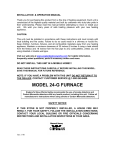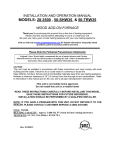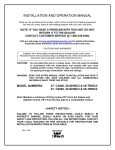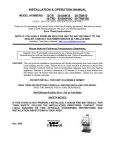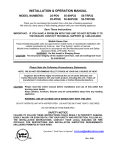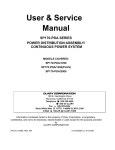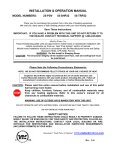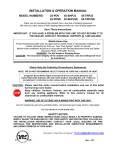Download England's Stove Works 50-TRW15 Operating instructions
Transcript
INSTALLATION & OPERATION MANUAL Thank you for purchasing this product from a fine line of heating equipment. We wish you many years of safe heating pleasure. Visit our web site at www.englanderstoves.com for helpful information, frequently asked questions, parts & accessory orders and more. NOTE: IF YOU HAVE A PROBLEM WITH THIS UNIT DO NOT RETURN IT TO THE DEALER. CONTACT CUSTOMER SERVICE @ 1-800-245-6489. CAUTIONS AND WARNINGS: READ THESE INSTRUCTIONS CAREFULLY BEFORE INSTALLING THIS MODEL. CAUTION: This stove must be installed in accordance with the Manufactured Home and Safety Standard (HUD), CFR 3280, Part 24 and must comply with local building and fire codes. Failure to follow these instructions could result in property damage, bodily injury or even death. Keep children, furniture, fixtures and all combustibles away from any heating appliance. NOTE: THIS STOVE IS MOBILE HOME AND DOUBLE WIDE APPROVED (WITH OUTSIDE AIR HOOK-UP). DO NOT INSTALL IN A SLEEPING ROOM. THE STRUCTURAL INTEGRITY OF THE MOBILE HOME FLOOR, WALL AND CEILING/ROOF MUST BE MAINTAINED. England’s Stove Works highly recommends the use of smoke detectors and Carbon Monoxide detectors with any hearth product, including this unit. Follow all manufacturer’s instructions when using smoke or Carbon Monoxide detectors. This product contains a catalytic combustor, which needs periodic inspection and replacement for proper operation. It is against the law to operate this wood heater in a manner inconsistent with the operating instructions in this manual, or if the catalytic element is deactivated or removed. Our catalytic stoves are designed to burn seasoned, dry wood. 18-MH, 50-SHW15 & 50-TRW15 COMPLIANCE STATUS TYPE FUEL EPA CERTIFICATE NO. EMISSION RATE OVERALL TEST EFFICIENCY REV. 8/06 WOOD 335 1.97 GRAMS/HR 80.6% A letter from our Technical Support department: Thank you for purchasing this fine product from England’s Stove Works! England's Stove Works was started, and is still owned by, a family that believes strongly in a "Do It Yourself" spirit – that’s one reason you found this product at your favorite “Do It Yourself” store. We intentionally design and build our stoves so that any homeowner can maintain his or her unit with basic tools, and we're always more than happy to show you how to do the job as easily and as inexpensively as possible. From our free, downloadable service sheets; to our Pellet Service Video; to our new "wizard-style," click-through Troubleshooting guide on our web site, we have always tried to help our customers stay "heat-ready," especially when oil and electricity prices continue to skyrocket. Please look at our vast Help section on our web site and call our Customer Service department at (800) 245-6489 if you need any help with your unit. We are nearly always able to help “walk you through” any repairs, problems or questions you may have. PLEASE NOTE: While information obtained on our web site and through our 800 number is always free of charge, there will be a service charge incurred with any “on-site” repairs or maintenance that we may arrange. Wishing you years of efficient, quality and “comfy” heating, England’s Stove Works Technical Support Department www.englanderstoves.com (800) 245-6489 IF YOU HAVE A PROBLEM WITH THIS UNIT DO NOT RETURN IT TO THE DEALER. CONTACT CUSTOMER SERVICE at 1 (800) 245-6489. SAFETY NOTICE: IF THIS WOOD STOVE IS NOT PROPERLY INSTALLED, A HOUSE FIRE COULD RESULT. FOR YOUR SAFETY, FOLLOW THE INSTALLATION DIRECTIONS. CONTACT YOUR LOCAL BUILDING OR FIRE OFFICIALS ABOUT RESTRICTIONS AND INSTALLATION INSPECTIONS IN YOUR AREA. OUTSIDE AIR MUST BE PROVIDED WHEN INSTALLING THIS UNIT IN A MOBILE HOME OR DOUBLE WIDE. SECTION I: FLUE SYSTEM FOR 18-MH, 50-SHW15 and 50-TRW15 A. Existing Flue System If you have chosen a freestanding unit, this unit is designed to connect to an existing flue system, such as masonry or a pre-manufactured Class A flue system. If you have a masonry system you should inspect the inner liner very carefully for cracks; if any are there, we recommend you install or have a stainless steel liner installed. If you have an existing pre-manufactured flue system you should inspect the inner liner to ensure there is no buckling, warping or cracks in the liner. Whether your flue system is masonry or pre-manufactured, it should be cleaned before installing the new unit to the flue system. We strongly recommend you have a qualified chimney sweep clean and inspect your flue system. The sweep in most cases will be able to make any necessary repairs or at least recommend qualified people to do so. It is not permissible to connect your new unit to a flue system that services another heating appliance. B. Flue Size Needed The proper flue size is determined by measuring the inside diameter of the flue collar on the unit. This unit is equipped with a six inch (6”) TOP EXHAUST FLUE COLLAR. Therefore, the connector pipe should be six inches (6”) or larger pipe and never less in diameter than the flue collar on the stove. The area of the chimney liner must also be equal to or greater than the area of the flue collar on the stove. If the area of the flue is greater than the area of the collar, it should never be more than three (3) times greater. EXAMPLE The area of a six inch (6”) flue collar is 28.87 square inches; therefore, the connector pipe should be a six inch (6”) diameter pipe and the chimney liner should be a minimum of 28.87 square inches, but no greater than 84.8 square inches. The connector pipe should be 24 gauge steel pipe and eighteen inches (18”) from a combustible wall or ceiling. If you require closer clearance to combustibles with your pipe, double wall or shielded pipe is available. This will reduce your clearance to six inches (6”). Figure 1 - Installation of 18-MH, 50-SHW15 and 50-TRW15 using Pre-Manufactured Chimney Note on Outside Air Hookup: You can use an outside air hookup with our catalytic stoves. We highly recommend it for homes built since the more air-tight construction standards went into effect. This involves connecting a metal pipe (usually three inches (3”) in diameter - check your stove - and the pipe can be flex or rigid) from the air inlet pipe located on the bottom rear of the stove through your floor or wall. The outside end of this pipe should be covered in some manner (i.e. with a screen) to keep it clear of foreign matter. It is necessary to use this hookup if installing in a mobile home or double-wide. Figure 2 - Installation of 18-MH, 50-SHW15 and 50-TRW15 using Masonry Chimney C. Installation of a New Flue System 1. Masonry Flue: In the event that you plan to install a flue system or have a flue system installed, there are several avenues you can take. In the middle and late Seventies masonry flue systems became very popular, and are satisfactory systems to have today. If you are considering a masonry system, you should consult your local building officials for the proper procedures in construction of this type flue system. We recommend you consult with and have your flue built by a licensed, bonded contractor. Most masonry flues are placed against the outside wall and extend upward above the roof. The flue thimble is then inserted through the wall, making the connection with the vertical flue and the stovepipe. Exercise extreme caution when drilling through the wall; you must maintain the proper clearance between the connecting liner and any combustibles in the wall. We also recommend that you have a flue door located at least two feet (2’) below your flue thimble connection for easy access and clean-out. You should make this door as airtight as possible. It is the responsibility of the consumer to ensure the chimney or flue system is in good operating condition. The manufacturer will not be responsible for an accident attributed to a unit connected to a faulty chimney or flue system. 2. Pre- Manufactured Flue System: In the past few years pre-manufactured flue systems have become very popular because this type system is fairly easy to install and, when installed correctly, is very safe. There are many pre-manufactured flue systems on the market from which to choose. In making your choice be sure the system you choose has a recognized label such as U.L., B.O.C.A. or I.C.B.O. Any of these labels will ensure the flue system is constructed of the proper materials and meets the required safety standards. Your Englander dealer will usually handle a top grade and approved flue system. There are two very popular methods for installation of a pre-manufactured flue system. The most popular and least expensive is through the ceiling and out the roof. This is the least expensive and creates a tremendous draw because less pipe is required. It is less expensive because insulated pipe is only needed from the ceiling up; single wall 24 gauge pipe is used from the unit to the ceiling. The second method of installation is to go through the wall and up on the outside of the house or structure. This method is more expensive because more insulated pipe is required; you must use insulated pipe through the wall and up the outside of your house. If you choose to go through the ceiling or through the wall, you must exercise extreme caution in your installation. The proper clearances must be maintained with either installation. Your flue pipe manufacturer furnishes a wall thimble or ceiling box, and when these are installed properly the correct safety clearances will be met. If you choose this type system and are not qualified to install it, you can contact your local dealer for a qualified contractor. It is the responsibility of the consumer to ensure the chimney or flue system is in good operating condition. The manufacturer will not be responsible for an accident attributed to a unit connected to a faulty chimney or flue system. *IMPROPER INSTALLATION: The manufacturer will not be held responsible for damage caused by the malfunction of a stove due to improper venting or installation. Call (800-245-6489) and/or consult a professional installer if you have any questions. SECTION II: FLOOR & WALL PROTECTION A. Floor Protection If your floor is constructed of a noncombustible material such as brick or concrete, no floor protection is required. If your floor is constructed of a combustible material such as hardwood, carpet or linoleum, you must place floor protection between the unit and the combustible material. There are many stove floor and wallboards on the market. You must be very cautious in choosing the proper protection. The board must be U.L. listed. After examining the area in which you plan to place your new unit and determining it requires protection, the next step is to select the proper size board. The unit you choose will determine the size board that is required. The approved board should be large enough to provide a minimum of eight inches (8”) behind the unit, eight inches (8”) on each side of the unit and sixteen inches (16”) in the front of it. This stove requires a minimum 36” x 48” floor protector. B. Wall Protection Your stove can be placed within thirty inches (30”) of a combustible wall such as paneling, wallpaper or drywall. In some areas local code may call for thirty-six inches (36”) clearance from a combustible, therefore you should check to see which applies to your area. If you need to place your unit closer it will require wall protection. There are many wall board manufacturers, and most require a one inch (1”) air space between the wall and the board. You can place your unit within twelve inches (12”) of some boards and reduce your clearance by two-thirds. In addition, the wallboard only needs to be six inches (6”) higher than the top of the stove; by placing the unit twelve inches (12”) from a combustible, the flue pipe will be closer than eighteen inches (18”) from a combustible surface. This will require you to use double wall or shielded pipe that allows you to come within six inches (6”) of a combustible surface. Regardless of clearances, we recommend using some type wall protection when installing this unit in a mobile home or double wide. Always follow the pipe and board manufacturer’s directions, and contact us if you have any questions. C. Heat Shield This stove has a standard heat shield that allows six inches (6”) clearance from combustibles across the entire rear of the stove. You will still need thirty inches (30”) clearance from combustibles on each side of the stove. SECTION lll: FREESTANDING PLACEMENT AND INSTALLATION Once you have your flue system complete and have installed the floor and wall protection, you are ready to place your unit. The first problem you may encounter is getting the stove into your home; all of our products are well constructed, which makes them rather heavy. To lighten the stove you can remove the door and firebrick. Be sure to make a note of your unit’s brick placement before you remove your bricks. After the unit is in place the firebrick and door can be replaced. We recommend you use a handcart and never try handling one of our units without some help. As a rule, three or four adults can handle most of our products. A. Chimney Connector The chimney connector must be 24 gauge steel pipe and six inches (6”) in diameter. Do not use aluminum or galvanized pipe for installation of this unit, as this type pipe will not be able to withstand the extreme temperatures a wood stove will generate. Do not use chimney connector pipe (single wall) as a chimney. You must connect your stove to a chimney comparable to those listed previously in this manual (See Section l). A chimney connector must be attached to the stove (and to each other) with the crimped end toward the stove. This allows any creosote to run back inside the pipe and not down the outside of the pipe. As a safety precaution, all joints should be sealed with high temperature silicone (AC-RTV3) and secured with three sheet metal screws, since the pipe could vibrate apart in the event of a creosote fire. For proper operation, the chimney connector should be as short as possible. Horizontal runs of chimney connector pipe should have an upward slope from the stove of one-quarter inch (1/4") per foot. Maintain eighteen inches (18”) of clearance between the chimney connector and the wall and ceiling unless a wall protection system is installed. When installing this stove in a mobile home or double wide you must use double wall or shielded pipe that will allow six inches (6”) clearance from a combustible. B. Outside Air Connection When installing this model in a mobile home or double wide it is necessary to supply the combustion air into the unit from outside the dwelling. This can be done by running a thin gauge three inch (3”) pipe (flex or rigid) from the air inlet pipe located on the rear of the stove through the floor or wall. The outside end of this pipe should be covered in some manner to keep it clear of foreign matter. If you are installing this stove in a regular dwelling this connection is not necessary, but is recommended in air-tight homes. SECTION IV: ACCESSORY ITEMS There are several accessory items available for your wood stove. It is suggested you install any accessory items before reading the next section; if you do purchase accessories after burning the stove, simply let the unit cool down and add the accessories as follows: AC-101-P & SH-101-P Brass Lip Trim There are two (2) pieces of J-Channel Trim in this kit that snap onto the edges of the stove. They cover the top front edge, the two vertical front edges and the ash apron front edge. To remove the protective plastic film, start at one end of the piece and peel off the film. The pieces are precut -- simply match the piece with the proper edge. After centering the channel on the edge with the short side of the channel down, force the underside of the J-Channel over the edge of the metal. If the J-Channel is too tight, get it started by hand then lightly tap into place with a wooden block or a rubber hammer. If the J-Channel is too loose and will not stay in place, lay the piece on a flat surface and bend the short side in on each end and slightly in the middle. Follow this procedure with each piece. AC-106-P & SH-106-P Brass Window Trim With the door closed, take the spring clip that has a tee on one end and twist it into the groove on the rear side of the window trim. You can place the spring clip on any side of the trim; however, the side of the trim toward the bottom of the door is best. Hold the spring clip in place and slide the bottom edge of the trim into the bottom ledge of the window opening. Press down and in with both hands, pushing the brass trim into position, then press in on all corners to ensure they are in the window opening as far as they will go. It is acceptable to use furnace cement on the rear side of the brass trim to help hold it in place. AC-02 Brass Rail This accessory is pre-mounted on a metal base and simply sits on top of the stove. You may order parts and options on our web site: www.englanderstoves.com or by calling (800) 516-3636 SECTION V: OPERATING INSTRUCTIONS A. Building a Fire Your stove is equipped with a catalytic combustor that requires the following procedure for firing the unit from a cold start. Inspect your stove to be sure the combustor is well-seated in the combustor housing before starting this procedure. CAUTION: NEVER LIGHT YOUR FIRE WITH KEROSENE, GASOLINE OR CHARCOAL LIGHTER FLUID. THIS COULD BE VERY DANGEROUS. NOTICE: Your new stove and the connector pipe may smoke for a period of time. This is called “cooking out” and is no cause for alarm. It is a good idea to open all doors and windows in your dwelling during the first two hours of operating a new unit. 1. Be sure there are no combustible materials in the immediate area. 2. Pull out completely the slide damper control (located under the ash lip) and the by-pass damper located on the top right side of the stove. 3. Place several wads of crushed newspaper over the entire bottom of the firebox. 4. Lay small dry sticks of kindling on the top of the paper. 5. Ignite the paper. Leave the door cracked until the kindling is burning freely. 6. Once the kindling is burning well place several pieces of dry split wood on the fire and allow the wood to burn freely before closing the door completely. 7. Close the door and allow the fire to burn thirty (30) minutes to one hour. 8. Once you have established a hot bed of coals, open the by-pass damper, add more wood (fill the unit), close the door and allow the wood to burn another thirty (30) minutes. The final step is to close the by-pass damper and place the slide damper at your desired setting. Note: Pulling the slide damper out or towards you increases the amount of combustion air and allows a faster burn. Pushing the rod in or away from you slows down the amount of air and allows the stove to burn slower. NOTE: It is very important the above procedure be followed to ensure the catalytic combustor reaches the proper temperature. It is recommended the combustor be operated at 700 to1400 degrees Fahrenheit; the combustor itself has to be above 500 degrees Fahrenheit before it will accept the smoke. Operating the unit above 1800 degrees Fahrenheit will damage the combustor, although temperatures between 1400 and 1600 degrees are common. If minor build-up is evident on the combustor, run the stove at a high rate with the by-pass damper partially open to help clean the combustor. A one-quarter inch (1/4”) button plug is located on the top left side of the unit. This plug can be removed and a Condor probe thermometer (PART # AC-13) inserted, which will display the actual temperature of the combustor. This part can be ordered from the factory or through your local stove dealer. B. Draft Control This unit has a slide draft control located under the ash apron, which is used to regulate the amount of combustion air entering the firebox. This controls the amount of heat your stove produces, as well as the burn time. The more you open the draft by pulling out the handle, the more combustion air enters the firebox; this will cause the stove to burn hotter and faster. You will have to experiment with your unit for the most efficient setting, as no two systems are the same. If you have any problems regulating the unit please contact your local dealer or call the factory. C. Do Not Over-Fire Your Unit Burning flammable liquids, too much wood and trash in the stove can result in over-firing. If the chimney pipe turns red or even worse, white, the unit has been over-fired. This condition may ignite creosote in the chimney and possibly cause a house fire. If this does happen, immediately close the slide damper by pushing it in completely and also close the by-pass damper. Get out of the house and call the fire department. A chimney fire may cause structural damage to the chimney system, therefore do not use the stove again until the flue system is inspected and, if necessary, repaired or replaced. A chimney sweep can perform this inspection. D. Everyday Fueling Always open or pull out the by-pass damper before opening the door of the stove. The door should be cracked for five to ten minutes to allow the excess smoke to clear through your flue system. Never open the door with the by-pass damper closed. This stove is designed to burn six to eight hours on one load of seasoned firewood. Once you have opened the door properly, you should have a bed of hot coals in the bottom of the firebox. With the use of a poker, pull the bed of hot ashes towards the door or front of the unit. Now you can fill the stove with seasoned wood, close the door and allow the unit to burn freely for approximately thirty (30) minutes. The final step is to close the by-pass damper and set your draft control to your desired burn. Follow this procedure each time you fuel your stove. E. Ash Removal and Disposal Regularly inspect the ash build-up in your stove and remove as necessary. Ashes should be placed in a metal container with an airtight lid. Pending final disposal, the ashes should be placed on a non-combustible surface, completely away from all combustible materials. The ashes should be retained in the closed container until all cinders have thoroughly cooled. If you have a masonry chimney or a pre-manufactured chimney system, it is essential that your flue be checked for creosote build-up at least twice per month. SECTION VI: CARE AND MAINTENANCE A. Catalytic Maintenance Note – Your unit will have a 3” thick, 25-cell combustor (manufactured by Applied Ceramics), or it will have a 1” thick, “ceramic foam” type combustor (manufactured by Clear Skies). The following instructions apply to both types, unless otherwise specified. 1. To reach the combustor, first take out the flame impingement plate by removing the four (4) 3/8” brass nuts (they take a 9/16” wrench). Once the nuts are removed the plate should drop from the four bolts. This will allow you to see the bottom of your catalytic combustor. 2. For 25-cell Applied Ceramics combustor: If the combustor is plugged up you will see black soot within the cells on the bottom side of the ceramic piece. This can usually be removed by brushing the combustor with a soft bristled brush. You can also run a pipe stem cleaner through each cell for removal of any internal build-up. This type cleaning can be done without removing the combustor from the stove. 3. For 1” thick Clear Skies combustor: Follow the instructions provided by Clear Skies pertaining to the cleaning of their combustor. 4. The flame impingement plate (Part #IP-18PC) is held in the unit as described previously. This can be cleaned with a stiff bristled brush. 5. The combustor collar (Part #CA-1710) is also held in place by four (4) 3/8” brass nuts (they take a 9/16” wrench). The flame impingement plate must be removed before the combustor collar. Once the second set of nuts is removed the collar will come out with the catalytic combustor seated in it. Reverse this procedure to replace the collar and flame impingement plate. 6. The catalytic combustor (Part #AC-6C3) is guaranteed by the manufacturers. A separate warranty card will be in the manual for this part and should be mailed back to the combustor manufacturer. Both combustors are equivalent, and in the event there is a problem with this item, Customer Service should be contacted at 1-800-245-6489. B. Gaskets Each unit comes with a gasket around the door, which should be replaced every two years. To replace the door gasket (Part # AC-DGKC), the old gasket should first be removed entirely. This may require you to scrape the old gasket and cement from the channel before adding new cement and 3/4” rope gasket. After attaching the new gasket, close the door and allow 24 hours for the cement to harden. If you are replacing the window gasket (Part #AC-GGK), the gasket already has adhesive on one side. Remove the paper on the adhesive side and place the gasket around the outside edge of the glass. The easiest way to do this is to form a “U” with the gasket and place this around the outer perimeter of the glass. The door gasket as well as the window gasket can be ordered from your local dealer or from our factory. C. Firebrick (Part #AC-SB; 20 Required) This stove is equipped with high density, high temperature firebrick. If the brick becomes chipped or cracked, especially on the sides of the firebox, it should be replaced. The brick can be ordered from your local dealer or from the factory. D. Finish (Part #AC-MCSP; 12 oz. Spray Can) Your stove has been painted with 1200 degree Metallic Charcoal paint that will retain its original appearance for years. However, if your stove should get wet, some rust spots may appear. These can be removed with plain steel wool and touched up with new paint. If you need to repaint the unit, use our paint as other brands may not be able to withstand the high surface temperatures. This spray paint can be ordered from your local dealer or from the factory. SECTION VII: CHIMNEY AND FLUE PIPE MAINTENANCE A. Chimney System Many stove owners prefer to clean their own chimneys; however, we highly recommend a chimney sweep be contacted to do this job. A professional sweep can clean and inspect your system and in some cases spot problems that you may overlook. B. Flue Pipe Maintenance When connecting your unit to the flue system, 24 gauge or thicker pipe should be used. Your pipe should be cleaned at least once a year and inspected monthly. Most people will clean their pipe and stove at the end of the heating season as this will keep odors from entering the house during the summer months. The flue pipe should be replaced every three to five years, depending on the thickness of the pipe (thicker pipe will last longer). SECTION VIlI: THINGS THAT COULD CAUSE YOUR STOVE TO SMOKE It is very important that installations are made airtight. This is best accomplished by using furnace cement at all pipe joints and where the first section of pipe enters the stove and enters the chimney flue. Any existing air leaks will cause the air to draw at points where the least resistance is offered — such places are pipe joints, flue thimble, flue openings in the chimney, ash clean-out doors and cracks in the chimney. These areas may cause air to enter your system and not be drawn through the stove as necessary, which could result in a cool chimney, causing the smoke to build up in the system and eventually come back into the house. This is called “back puffing” and can be helped by sealing all troublesome areas so they are airtight. There are two main causes of chimney down drafts. One is from the air currents being deflected down the chimney by nearby objects such as trees, a building or a hill. The other cause is that in many chimneys the flue gases chill too quickly as they pass up the chimney system. When the flue gas cools too quickly, it becomes heavy and will back up in the system; this will often result in “back puffing,” poor combustion and smoke odors in the house. Burning the stove hotter will, in some cases, help this situation. If you have any problem with “back puffing” or a poor drawing chimney system, contact your local dealer or call the factory. SECTION IX: WHAT CAUSES CREOSOTE? Creosote is caused by the condensation of the vapor that exists in the escaping smoke; the moisture level of your fuel will determine the density of this vapor. A severe downdraft as discussed previously will also cause creosote. Moisture will form at the coolest point in your chimney system and at this point will tend to build creosote. The ash is picked up by the moisture in the system and will build up or run back down the inside of your flue. This situation can sometimes be helped by installing an “open vented” type chimney cap, which will allow the chimney to maintain more heat to create a better draw and keep some wind currents from entering the system. This type cap will not correct a poorly constructed chimney or one in need of repair. Such chimneys may have to be relined or rebuilt. REPLACEMENT PARTS FOR 18-MH, 50-SHW15 and 50-TRW15 AC-DGKC DOOR GASKET KIT AC-FCGK FLUE COLLAR GASKET KIT AC-SB 9” X 4” X 1 ½” FIREBRICK (20) AC-G9 9” X 9” GLASS W/GASKET AC-GGK GLASS GASKET KIT (gasket only, no glass) AC-SH DOOR SPRING HANDLE AC-SH4 SLIDE DRAFT SPRING HANDLE AC-SHM BY-PASS SPRING HANDLE AC-6C3 CATALYTIC COMBUSTOR AC-MCSP HI-TEMP METALLIC PAINT CA-1710 COMBUSTOR HOUSING CA-20 6” FLUE COLLAR IP-18PC FLAME IMPINGEMENT PLATE NOTE: Accessory items and trim (found in Section IV of this manual) may also be ordered. NOTE: ALL PARTS CAN BE ORDERED FROM YOUR LOCAL DEALER, FROM OUR FACTORY, OR FROM OUR WEB SITE. www.englanderstoves.com If you have any questions or problems contact our Customer Service Department at 1-800-245-6489. CUSTOMER SERVICE DEPARTMENT P.O. BOX 206 MONROE, VA 24574 Tech. Questions (800-245-6489) (FAX 434-929-4810) Parts Orders ONLY (800-516-3636) Have this information on hand if you phone the factory or your dealer regarding this product. Retain for your files: Model Number __________________________ Date of Purchase ________________________ Date of Manufacture _________________ Serial #_____________________ LIMITED 5 YEAR WARRANTY FROM THE DATE OF PURCHASE TO THE ORIGINAL OWNER The manufacturer extends the following warranties: Five Year Period: 1. Carbon steel and welded seams in the firebox are covered for 5 years against splitting. 2. The cast iron door, hasp and hinges are covered for 5 years against cracking. One Year Period: 3. Component parts such as combustor housing, flue collar, flame impingement plate, baffle plate, brick retainers, combustor plate and fasteners are covered for 1 year against cracking, breakage and welded seams from separating. 4. Electrical components, accessory items, glass and the painted surface are covered for 1 year from the date of purchase. Conditions and Exclusions: Damage from over-firing will void your warranty. This warranty does not apply if damage occurs because of an accident, improper handling, improper operation, improper installation, abuse, or unauthorized repair made or attempted to be made. The manufacturer is not liable for indirect, incidental, or consequential damages in connection with the product including any cost or expense providing substitute equipment or service during periods of malfunction or nonuse. All liability for any consequential damage for breach of any written or implied warranty is disclaimed and excluded. Some states do not allow the exclusion or limitations of incidental or consequential damages, so the above may not apply to you. Procedure: Purchaser must give notice of claim of defect within the warranty period and pay transportation to and from a service center designated by the factory. The dealer from which the unit was purchased or the factory, at our option, will perform the warranty service. Other Rights: This warranty gives you specific legal rights, and you may also have other rights, which may vary from state to state. NOTE: THIS WARRANTY IS NULL AND VOID IF YOU DO NOT RETURN THE ATTACHED WARRANTY REGISTRATION WITH A COPY OF THE SALES RECEIPT WITHIN 30 DAYS FROM THE DATE OF PURCHASE. WARRANTY IS NOT TRANSFERABLE. WARRANTY REGISTRATION for England’s Stove Works Purchased by (Name) ______________________________________________ Address _________________________________________________________ City ________________________ State __________ Zip _________________ Telephone _______________________________________________________ Email Address ___________________________________________________ DEALER INFORMATION Purchased From (Dealer) ___________________________________________ Address _________________________________________________________ City ________________________ State __________ Zip _________________ UNIT INFORMATION (Please be sure to refer to sticker on back of manual or box to complete this section) Model Number _____________________ Purchase Date _________________ Purchase Price ____________________ Serial Number _____________________ Mfg. Date ______________________ How did you first hear about our product? (please check one) ___ Word of Mouth ___ Burn Trailer Demonstration ___ Internet Other: ____________________________________________________ Where did you receive information about our product? (please check one) ___ Rec’d. info. via phone ___ Dealer (Name of dealer): _____________________ ___ Internet Other: _________________________________________________ IMPORTANT NOTICE THIS REGISTRATION INFORMATION MUST BE ON FILE FOR THIS WARRANTY TO BE VALID. PLEASE MAIL THIS INFORMATION WITHIN THIRTY (30) DAYS FROM THE DATE OF PURCHASE. Mail To: England’s Stove Works, Inc. Customer Service Department P.O. Box 206 Monroe, VA 24574 Or, Fax To: (434) 929-4810 – 24 hours a day Or, now available – Go online to complete your Warranty Registration! Visit www.englanderstoves.com if you prefer to register online.

















